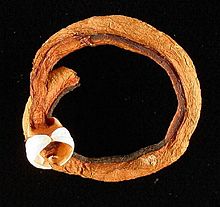Shipworm
| Naval shipworm | |
|---|---|
 |
|
| Scientific classification | |
| Kingdom: | Animalia |
| Phylum: | Mollusca |
| Class: | Bivalvia |
| Order: | Myoida |
| Family: | Teredinidae |
| Genus: | Teredo |
| Species: | T. navalis |
| Binomial name | |
|
Teredo navalis Linnaeus, 1758 |
|
| Synonyms | |
|
|
Teredo navalis, the naval shipworm, is a species of saltwater clam, a marine bivalve mollusc in the family Teredinidae, the shipworms. This species is the type species of the genus Teredo. Like other species in this family, this bivalve is called a shipworm, because it resembles a worm in general appearance, while at the anterior end it has a small shell of two valves which is specialised to bore through wood.
This species may have originated in the northeast Atlantic Ocean, but has spread around the world. It tunnels into underwater piers and pilings and is a major cause of damage and destruction to submarine timber structures and the hulls of wooden boats.
Teredo navalis has an elongated, reddish, wormlike body which is completely enclosed in a tunnel it has made in floating or submerged timber. At the front end of the animal are two triangular, calcareous plates. These are up to 2 cm (0.8 in) long and correspond to the valves of other bivalve molluscs. They are white, with a covering of pale brown periostracum, and have rough ridges. The mollusc uses them to rasp the wood and slowly enlarges the burrow in which it lives. It has retractable inhalant and exhalant siphons which project through a small hole in the horny septum which blocks the opening of the burrow. When the animal is threatened, the siphons can be drawn inside the burrow and protected by a pair of calcareous oar-like pallets. The tunnel is circular in cross section and is lined with calcareous material extruded by the mollusc. It can be up to 60 cm (24 in) long and 1 cm (0.4 in) in diameter.
Teredo navalis is found in temperate and tropical seas and oceans worldwide. It may have originated in the northeast Atlantic Ocean, but it is difficult to establish where it originally came from because it has spread so efficiently around the world. It is found in the littoral zone, living inside submerged timber, pilings, driftwood, and in the hulls of wooden boats. It is found in brackish waters as well as the open sea, and tolerates salinities ranging from five to thirty-five parts per thousand. It is also tolerant of a wide range of temperatures. Individuals have survived temperatures as high as 30 °C (86 °F) and as low as 1 °C (34 °F), though growth and reproduction are restricted to the range from 11 °C (52 °F) to 25 °C (77 °F). It can also live without air for about 6 weeks, using up its stored glycogen reserves. Dispersal to new habitats occurs both during the free-living larval stage, by floating timbers carried along by currents, and, historically, from the hulls of wooden vessels. In the Baltic Sea, there were several mass occurrences in the 1930s and 1950s.
...
Wikipedia
